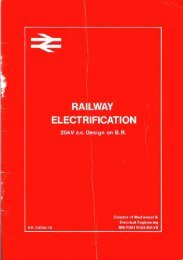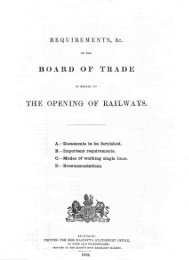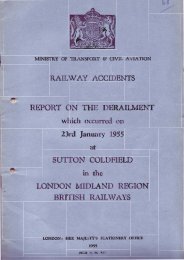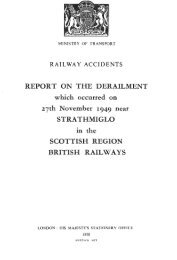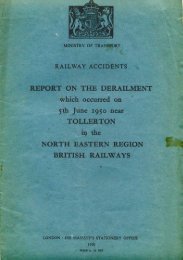R A I LT R AC K - The Railways Archive
R A I LT R AC K - The Railways Archive
R A I LT R AC K - The Railways Archive
You also want an ePaper? Increase the reach of your titles
YUMPU automatically turns print PDFs into web optimized ePapers that Google loves.
Integrated transport<br />
In the past 12 months,the Government has published<br />
its White Papers A New Deal for Transport:Better for Everyone<br />
and Travel Choices for Scotlandtogether with a number of<br />
supporting documents setting out more detailed policies.<br />
Among these were the response to the Environment,<br />
Transport and Regional Affairs Committee Report on the<br />
Proposed Strategic Rail Authority and Railway Regulation<br />
which set out the Government’s plans for the rail industry in<br />
more detail.<br />
<strong>The</strong> rail industry has welcomed the emergence<br />
of an Integrated Transport Policy and is working actively<br />
towards the achievement of its objectives and contributing<br />
positively to policy development.<br />
<strong>The</strong> fo l l owing are planned or have already been delive r e d<br />
against Gove rnment objective s .<br />
• More and better train services – an increase of 14% in<br />
passenger kilometres over the past two years – and an<br />
increase of 5% in train kilometres in 1998/99 compared<br />
to the previous year.<br />
• Better information – We control the national rail<br />
timetable and have made it available on the Internet –<br />
on average 850,000 Internet enquiries are successfully<br />
answered a week.<br />
• Better security – We and train operators are investing in<br />
improved security. Customer security staff have been<br />
recruited by train operators.<br />
• Easier access – Pilot schemes to make available secure<br />
bicycle storage and hire facilities are under way at main<br />
line rail stations.New services have opened connecting<br />
Heathrow with central London.<strong>The</strong>re are other plans<br />
under development.<br />
• Growth in train services of up to 30% over the next ten<br />
years.<br />
• <strong>The</strong> further development and integration of information<br />
systems.We are playing a full part in the feasibility<br />
studies for national information systems.<strong>The</strong> railway<br />
industry is also developing the integration of its different<br />
information systems to bring together timetables,fares<br />
and real-time train-running information.<br />
• We are working closely with the Highways Agency and<br />
Scottish Office to develop and exploit opportunities for<br />
managing transport corridors cross-modally.<br />
1.7<br />
1.7 Financing the Plan<br />
Maintenance and r e n ew a l . Train opera t o rs enter into tra c k<br />
access agreements with us which set out the term s ,i n c l u d i n g<br />
the access charges paya bl e, on which they are permitted to ru n<br />
t rains on specified parts of the netwo rk . Under these<br />
a g r e e m e n t s ,we are required to ensure that the netwo rk is<br />
maintained and operated to a standard which permits our<br />
c u s t o m e rs to deliver their obl i g a t i o n s .<br />
When the Rail Regulator determined the ove rall level of<br />
c h a rges to be paid by passenger franchise train opera t o rs fo r<br />
t rack access for the period to A p ril 2001, he took into account<br />
the extent of our proposed asset renewal programme and<br />
income earned from commercial development or sales of our<br />
p r o p e rt y.This means that we will fund the maintenance and<br />
renewal expenditure set out in this Statement pri m a ri ly from<br />
the income we receive from our customers under these access<br />
c o n t ra c t s .<br />
Some projects are not simply renewals but invo l ve<br />
elements – new techniques, European harm o n i s a t i o n ,o r<br />
renewal of historic structures in a manner in keeping with the<br />
o riginal design – which may attract grant funding.<br />
E n h a n c e m e n t . Our investment in commercial projects with<br />
an appropriate rate of return which enhance the netwo rk will<br />
u s u a l ly be recovered from additional access charges which we<br />
negotiate with our customers who benefit from the<br />
i nve s t m e n t .In most cases we would be taking market ri s k<br />
through a reve nue sharing deal.This is our prefe rred approach.<br />
For part n e rship projects, we would be prepared to<br />
finance part but not all of the capital cost including earning an<br />
a p p r o p riate rate of return and would look for grant funding to<br />
c over the balance. Such a grant would be paid in return for the<br />
b e n e fits to the community such as reduced tra f fic congestion.<br />
Existing public grant mechanisms allow for this via grants to<br />
passenger opera t o rs to pay additional access charges or by<br />
direct grant funding of assets by the Franchising Director, l o c a l<br />
a u t h o rities and PTEs. For freight schemes, freight facilities gra n t s<br />
m ay be av a i l a bl e.A g a i n ,we would wish to take the market ri s k .<br />
For contractor projects we would again be prepared to<br />
fund the costs of construction either wholly or in part n e rs h i p<br />
but we would not take any commercial risk and would only<br />
r e c over our costs and standard rate of return through access<br />
c h a rg e s .<br />
<strong>The</strong> rail industry<br />
has welcomed the<br />
emergence of an<br />
Integrated<br />
Transport Policy<br />
19



